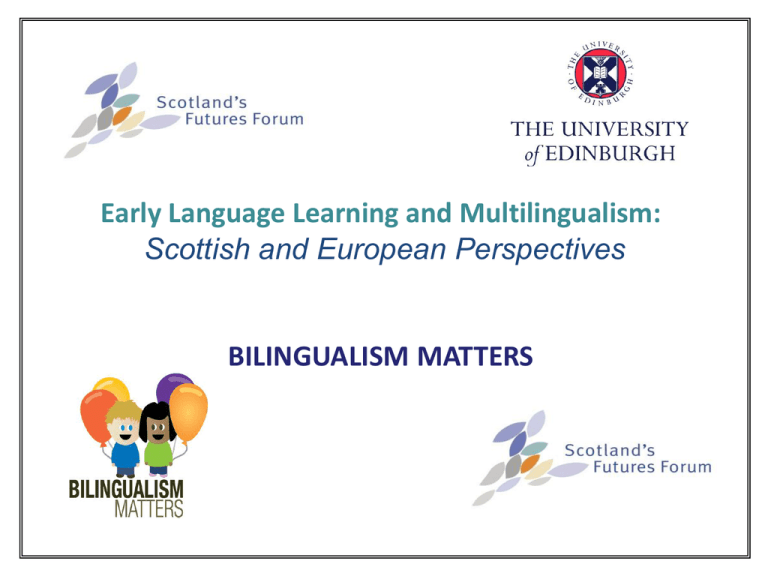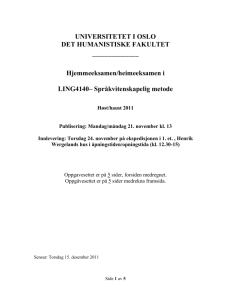7_Vangsnes
advertisement

Early Language Learning and Multilingualism: Scottish and European Perspectives BILINGUALISM MATTERS Norway: Linguistically more diverse than you may have thought! Øystein A. Vangsnes Flere språk til flere (‘More languages to more people’) University of Tromsø, Norway Norway Population: 5 million Official language: Norwegian • Bokmål (majority) • Nynorsk (minority) Historical minority languages: Sámi Kven/Finnish Romani Romanes 3 08.04.2015 Scandinavia • Norwegian, Swedish and Danish are largely mutually intelligible. • the total number of (native) speakers of (Mainland) Scandinavian is about 20 million. • Norwegians do best in studies of inter-Scandinavian comprehensibility (only beaten by the Faroese). 4 08.04.2015 Language in the Norwegian educational system • English is introduced in the 1st grade (age 6). • A second foreign language is offered from the 8th grade (age 13). Spanish (31%), German (24%), French (14%) • Third foreign language can be chosen in last part of 2ndary school (age 16-18) • Most Norwegian children become fully functional in English; that is only rarely the case with the other foreign languages that are introduced later: Too late and too little! 5 08.04.2015 Minority languages supported by law • Sámi is offered by law as the main language of instruction in elementary school in core areas; also Sámi 1st language classes in cities like Tromsø and Oslo. • Sámi as 2nd language is also offered in core areas. • There are Sámi language kindergardens in core areas and some cities. • Finnish as 2nd language is offered by law in the two northernmost counties (Troms, Finnmark) when number of pupils > 3. • Norwegian Sign Language is offered by law to children who have it as their 1st language or who otherwise need it. 6 08.04.2015 Minority languages in general • There is an increasing awareness of the benefits of multilingualism and language stimulation in general in the pre-school system. • The education law focuses on raising the children’s competence in Norwegian, and instruction in native languages other than Norwegian and Sámi is primarily used as a tool to reach this goal. • Some 120 different 1st languages are taught to children in Norway – the biggest ones are Urdu, Somali, Arabic. • Bilingual children sometimes receive extracurricular instruction in their “other” language on an ad hoc basis; not a right by law. 7 08.04.2015 The indigenous Sámi languages 8 08.04.2015 9 08.04.2015 Literacy rates are strikingly different in Norway and Sweden: Norway offers primary education in Sámi; Sweden does not – Swedish is always the main language of instruction even in “Sámi schools”. 2nd language instruction in Norway does unfortunately not produce robust Sámi speakers either. 10 08.04.2015 Two written standards of Norwegian: Bokmål and Nynorsk • Bokmål: A gradual adaptation from Danish after independence from Denmark in 1814; main break by a reform in 1917 • Nynorsk: Established in the middle of the 19th century on the basis of Ivar Aasen’s comprehensive documentation of the rural Norwegian dialects; currently mostly used in the west and valley regions of the east 12 08.04.2015 Municipality language: Red = Bokmål Blue = Nynorsk Grey = Neutral Nynorsk vs. Bokmål vs. Swedish: The differences are small! Nynorsk: Nynorsk normaltalemål er lite utbreidd utanfor situasjonar der ein er bunden av manus, som nyheitsopplesarar og skodespelarar. Bokmål: Nynorsk normaltalemål er lite utbredt utenfor situasjoner der man er bundet av manus, som nyhetsopplesere og skuespillere. Swedish: Nynorskt normaltalspråk är lite spritt utanför situationer där man är bunden av manus, som nyhetsuppläsare och skådespelare. ‘Nynorsk normalized speech is not used much outside of situations where one is using a manuscript, such as news readers and actors.’ 13 08.04.2015 Bokmål vs. Nynorsk • Nynorsk is clearly the minority variety: 12,59% of the pupils in elementary school have Nynorsk as their language of instruction; 6-700.000 living Norwegians have grown up with Nynorsk. • Bokmål dominates mass media: Apart from the nationally supported broadcasting, there is little Nynorsk; there are no national daily newspapers in the language. • All pupils receive instruction in the “other variety” from 8th grade and onwards as part of the Norwegian curriculum, and there is a separate exam last year of high school. 14 08.04.2015 Bidialectal literacy • Kids who grow up with Nynorsk are also massively exposed to Bokmål, hence acquire a much more balanced proficiency in the two varieties than vice versa: Are there “bilingual effects”? • A recent study (Vulchanova et al. 2013) show that persons who use Nynorsk actively (i.e. write it on a regular basis), are better at reading both Nynorsk and Bokmål than persons who only use Bokmål. • Preliminary calculations (by Vangsnes et al.) suggest a statistically significant correlation between good school achievement and percentage of Nynorsk in the municipalities when leveled for socio-economic factors (education, income, single parenting). 15 08.04.2015 Summary and conclusions • Norway is a linguistically diverse country, although it might not seem like it on the surface! (Two standard varieties of Norwegian, high tolerance for dialects, three Sámi languages, other historical minority languages, a large number of “new” minority languages.) • Statistical figures regarding the minority variety Nynorsk suggest that bidialectal literacy give positive effects. • Literacy is also an important aspect of sustaining threatened minority languages such as Sámi. 16 08.04.2015
